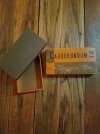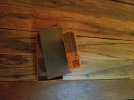-
The BladeForums.com 2024 Traditional Knife is ready to order! See this thread for details: https://www.bladeforums.com/threads/bladeforums-2024-traditional-knife.2003187/
Price is $300 ea (shipped within CONUS). If you live outside the US, I will contact you after your order for extra shipping charges.
Order here: https://www.bladeforums.com/help/2024-traditional/ - Order as many as you like, we have plenty.
You are using an out of date browser. It may not display this or other websites correctly.
You should upgrade or use an alternative browser.
You should upgrade or use an alternative browser.
Carborundum Co. 109 SIC
- Thread starter hughd
- Start date
- Joined
- Apr 12, 2009
- Messages
- 13,386
I've never found any published grit specs for older Carborundum-branded stones. I have a Carborundum 111 stone, in 5" x 2" x 3/4" size, that I found among some items of my Dad's after he passed away. No numbers for grit on the box; in fact, they only label it as 'Double Grit', not even specifying a 'coarse', 'medium' or 'fine' for either side. I haven't used the stone yet. But by appearance and feel in-hand, this stone seems on par with other such SiC stones from Norton (Economy stone), Sears and ACE Hardware. In other words, maybe ~ 120 or so on the coarse side, and something in the 280-320 range on the fine side. I'm basing those numbers on Norton's grit chart for their SiC stones (Crystolon, including the 'Economy' stone). Norton's the only brand I know of with published grit specs for stones like these. Just so happens, Norton's current parent company, Saint-Gobain, is also the current owner of the Carborundum brand products of today. Still hard to know for sure though, what the older Carborundum is, based on only looks or feel in-hand.
Last edited:
- Joined
- Dec 21, 2006
- Messages
- 3,158
That is my impression as well. Coarse is 120, Fine is ~300.
- Joined
- Feb 18, 2014
- Messages
- 543
Some interesting information here...
https://archive.org/details/CarborundumPocketCatalog1906
https://archive.org/details/NortonOilstonesAbrasiveSpecialities1935
https://archive.org/details/CarborundumPocketCatalog1906
https://archive.org/details/NortonOilstonesAbrasiveSpecialities1935
Last edited:
David Martin
Moderator
- Joined
- Apr 7, 2008
- Messages
- 19,520
Ok, this topic needs a photo of a box that the Carborundum Co. put their stone in. One can date it from the box. Otherwise it is a guess
as to the grit. Here is mine, a 2"X 4" stone. This stone was manufactured at the Niagara Falls plant operated from 1915-1969 or longer.
But this style box with the Native American Chief on the front will date it circa, 1940-55's. DM

as to the grit. Here is mine, a 2"X 4" stone. This stone was manufactured at the Niagara Falls plant operated from 1915-1969 or longer.
But this style box with the Native American Chief on the front will date it circa, 1940-55's. DM

David Martin
Moderator
- Joined
- Apr 7, 2008
- Messages
- 19,520
On the end of the box is the information about the stone. Mine is a 118S, fine. Comparing this stone to my Jum-3 the fine side, the 118 is much finer. The fine on the JUM-3 is stated at 280 or 300 grit. The 118 stone feels closer to 450-500 grit. I got the stone, slightly used but
most likely near new. I use it for burr removal on the final grit when I can't get them removed on the JUM-3. DM

most likely near new. I use it for burr removal on the final grit when I can't get them removed on the JUM-3. DM

- Joined
- Mar 8, 2008
- Messages
- 25,891
Actual grit, for the most part, doesn't much matter in a practical descriptive sense unless you're comparing it to other stones of otherwise equal overall composition. There are so many other variables involved that it's really more about the results produced compared to other stones in your lineup. 
- Joined
- May 20, 2007
- Messages
- 3,368
I find there are many very subjective terms that dont matter much, including "cutting speed" that don't tell you squat, unless comparing to other stones.Actual grit, for the most part, doesn't much matter in a practical descriptive sense unless you're comparing it to other stones of otherwise equal overall composition. There are so many other variables involved that it's really more about the results produced compared to other stones in your lineup.
I could be wrong, but I think the OP just wants to know the "advertised" grit was from an "antique" stone that came into his possession.
Russ
- Joined
- Apr 12, 2009
- Messages
- 13,386
Actual grit, for the most part, doesn't much matter in a practical descriptive sense unless you're comparing it to other stones of otherwise equal overall composition. There are so many other variables involved that it's really more about the results produced compared to other stones in your lineup.
That's how I rate them as well, in terms of the finish left on the bevels & edge, as compared to other stones used on the same blades. Things like differences in slicing aggression in paper can tell a lot as well. I think when I get around to testing my 111 stone, I'll first use it side-by-side with one of my Norton Economy SiC stones to see how they compare in results.
David Martin
Moderator
- Joined
- Apr 7, 2008
- Messages
- 19,520
Those Norton Economy stones, i.e. the ACE Hardware stone is a more coarse grit than my JUM-3. A telling sign is I have to use vasoline & oil
to keep the stone lubricated and how fast they cut. So, they are different grit. I'd say the coarse side is closer to 80-90 grit and the fine side is more like a medium, 200 grit. DM
to keep the stone lubricated and how fast they cut. So, they are different grit. I'd say the coarse side is closer to 80-90 grit and the fine side is more like a medium, 200 grit. DM
- Joined
- Mar 8, 2008
- Messages
- 25,891
Usually that's more of an issue of porosity. That CAN be the result of the abrasive size, but that's more of like a secondary influencing factor. The grit/bond ratio (which does get impacted by grain size to a degree, but not 100%) and the press rate used in the molding process will have a larger impact. Highly porous stones likely have a low grit/bond ratio and low pressure in molding, which will also make them a softer bond, which increases cutting speed, but also the wear rate.Those Norton Economy stones, i.e. the ACE Hardware stone is a more coarse grit than my JUM-3. A telling sign is I have to use vasoline & oil
to keep the stone lubricated and how fast they cut. So, they are different grit. I'd say the coarse side is closer to 80-90 grit and the fine side is more like a medium, 200 grit. DM
- Joined
- Apr 12, 2009
- Messages
- 13,386
The ACE SiC stones are kind of a toss-up to me. I have their SiC versions in at least three sizes (8" x 2", 4" x 1-3/4" and a couple of pocket stones at 3" or so). The interesting thing is, each of those different sizes seems to behave somewhat differently than the others, in terms of edge-finishing. The 4" stone (double-sided) is becoming one of my favorites as a touch-up stone. It's Fine side seems to leave a cleaner, more refined edge than either of my other two ACE stones in 8" and 3" pocket-size. The 3" pocket stone (single grit) is kind of a mystery. It seems to leave a finish somewhat rougher/less clean than the Fine sides of either of the other two. This, in spite of the fact it still 'feels' just as fine, by touch, as the Fine side of the other two. I'm still trying to figure out what it's best-suited to, each time I use it.
Last edited:
David Martin
Moderator
- Joined
- Apr 7, 2008
- Messages
- 19,520
Ha, I have 3 of those stones as well, one combination 2"x 8" and two combination of the 2" X 6". Both of these seem to be the same grit base. Porous, shed grit and cut quickly. I have not tried the 4". I'll have to purchase that one. DM
